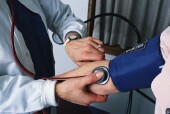- Navigating Your Midlife Crisis: Embracing New Possibilities
- City Raccoons Showing Signs of Domestication
- Mapping the Exposome: Science Broadens Focus to Environmental Disease Triggers
- One Week Less on Social Media Linked to Better Mental Health
- Your Brain Changes in Stages as You Age, Study Finds
- Some Suicide Victims Show No Typical Warning Signs, Study Finds
- ByHeart Formula Faces Lawsuits After Babies Sickened With Botulism
- Switch to Vegan Diet Could Cut Your Greenhouse Gas Emissions in Half
- Regular Bedtime Does Wonders for Blood Pressure
- Dining Alone Could Mean Worse Nutrition for Seniors
Lower Blood Pressure Reduces First Stroke Risk: Study


Keeping the top number in a blood pressure reading below 140 helps reduce the risk of stroke in healthy people 60 and older, according to a new study.
The findings challenge a report published last year in the Journal of the American Medical Association. The 2014 report said that doctors should aim for blood pressure readings of 150/90 mm Hg or lower for patients 60 and older who do not have diabetes or chronic kidney disease. That top number (the “systolic” reading) is 10 points higher than in previous recommendations and triggered controversy in the medical community.
High blood pressure “is the most established and modifiable risk factor for stroke, one of the leading causes of death and disability,” lead author of the new study, Chuanhui Dong, research associate professor at the University of Miami Miller School of Medicine, said in an American Stroke Association news release.
“Reduction in systolic blood pressure below 140 is important in primary stroke prevention, even among those over 60 [years of age] without diabetes or chronic kidney disease,” Dong said.
The new study included more than 1,700 New York City residents older than 60. Their average age was 72 years. None of them had diabetes, kidney disease or had suffered a stroke. But about 40 percent of the participants were taking blood pressure medication. Twenty percent had systolic blood pressure readings between 140 and 149, while 37 percent had readings over 150 mm Hg, according to the study.
Compared to participants with a systolic blood pressure below 140, the risk of first stroke was 70 percent higher in those with readings of 140 to 149. Stroke risk was 80 percent higher for those with readings at or above 150 compared to those whose pressure was under 140, the study found.
“This implies [systolic] blood pressure from 140 to 149 is just as strong of a stroke risk factor as levels of 150 and greater,” Dong said in the news release.
The findings support the concerns of experts who warned that raising the threshold for the systolic number to 150 mm Hg for healthy people could lead to more strokes, Dong added.
The researchers behind the new study also found that keeping systolic blood pressure lower may be especially important in preventing strokes in Hispanics, blacks and women, although the researchers noted the numbers of blacks and whites included in this study were small.
Compared to those with systolic readings below 140 mm Hg, the risk of first stroke was 2.4 times greater in Hispanics with readings of 140 to 149. For blacks with readings of 140 to 149, the risk of a first stroke was two times higher than in those with readings under 140 mm Hg, the investigators found.
In women with systolic blood pressure readings of 140 to 149, the risk of a first stroke was nearly twice as high compared to those with readings under 140 mm Hg. Among men, those with levels of 140 to 149 were 34 percent more likely to suffer a stroke than those with systolic levels below 140 mm Hg.
Results of the study are scheduled to be presented Wednesday at the American Stroke Association’s annual meeting in Nashville. Study findings presented at meetings are generally viewed as preliminary until they’ve been published in a peer-reviewed journal.
More information
The U.S. Centers for Disease Control and Prevention explains how to prevent high blood pressure.
Source: HealthDay
Copyright © 2025 HealthDay. All rights reserved.










